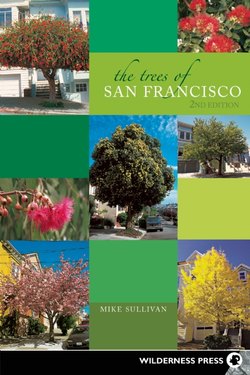Читать книгу The Trees of San Francisco - Michael Sullivan - Страница 8
На сайте Литреса книга снята с продажи.
ОглавлениеAbout This Second Edition
SOME 10 years have passed since the first edition of this book was published, and much can change in a decade, of course. My own family tree has grown, as I had dedicated the first edition to my son, Joseph, a few months before he was born. Now he is an engaging nine-year-old, and a lover of trees—especially of what he calls “his tree,” the thriving soapbark (Quillaja saponaria) that we planted in front of our house the week of his birth.
Ten years also have brought change to San Francisco’s evolving urban forest. More than a few of the trees that I highlighted in the first edition are no longer with us. Sadly, they’ve been victims of windstorms, truck collisions, disease, and old age. But the passage of a decade also allows this second edition to showcase new species, younger trees coming into their prime, and some jewels that had escaped my attention until recently (see for a great example of that). For any of you who are first-edition readers, and whose copy is worn and dog-eared, you’ll appreciate knowing that this new book offers many more close-up photos and five additional tree-focused walking tours (for a new total of 12). You’ll also enjoy an updated mix of short features, or sidelights, that take you deeper into San Francisco’s urban-forest history, culture, and idiosyncrasies.
Like its first-edition predecessor, The Trees of San Francisco is not a field guide, and it won’t overwhelm you with botanical vocabulary. It does, however, provide both common and scientific names for each tree, details of general interest, and some surprising facts about various species.
Rather than an exhaustive list of all the trees to be found in San Francisco, this collection presents in text and images the city’s most representative array. The entries appear in alphabetical order according to each tree’s common name, with its scientific name prominently displayed as well. Two or more photos accompany each entry, and captions pinpoint the locations of the trees depicted, making it easy for readers to visit them.
Interspersed among the entries for the trees, you will see the 13 “Sidelights” mentioned above. These brief features will inform and entertain you with unique stories or aspects about San Francisco’s trees, tree lovers, and tree origins.
In addition, on pages 86–136, the book leads you on 12 self-guided tours into diverse tree-rich neighborhoods. Following “Walking Tours,” you will come to “Landmark Trees,” which I humbly submit as my own list of the city’s most noteworthy and eye-catching trees. To make them easier to visit, I’ve grouped them within 23 neighborhoods that range from residential to commercial, and from waterfront to wooded.
All in all, if you liked the first edition, I think you’ll love the second!
